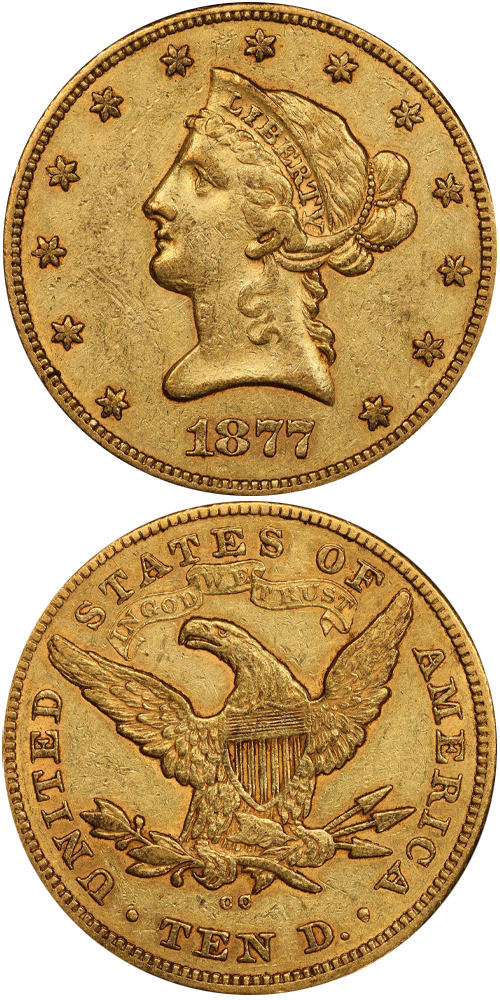1877-CC Liberty Head Eagle
Jeff Ambio: On the second reported obverse die for the 1877-CC eagle, the date is nearly centered in the field between the base of Liberty's portrait and the denticles. A loupe reveals remnants of extremely minor repunching at the right base of the digits 1 and the first 7. Only a single reverse is known, characterized by a small, round and level CC mintmark positioned entirely to the left of the lowermost arrow feather.
Rusty Goe: At the start of 1877, the Treasury Department kept the working mints on deadline to fulfill the quotas for subsidiary silver coins as required by the Specie Resumption Act. As of January, the reserves of such coins fell about $21 million short of the $50 million target. Other than the dimes, quarters, and half dollars flooding out of the mints, the only other priorities on the Treasury's schedule were double eagles and trade dollars.
At Carson City mechanical difficulties, and problems with the new dies sent from Philadelphia, delayed workers from making gold coins in the first three months of 1877. The local minters had also noticed that their share of the record outputs of Comstock ore had gradually diminished to disproportionately lower levels. Gold deposits had especially contracted.
At the mid-year point, the coiners in Carson City had turned out $2 million in silver pieces and a smaller-than-normal output of double eagles. Mint Director H.R. Linderman and an assistant visited Carson City in early July to personally inspect the mint's operations. The locals serenaded the director with a flag-waving Fourth of July brass-band performance. He addressed a gathered crowd and praised Superintendent James Crawford and his staff "for their integrity and faithfulness in the discharge of their respective duties." Seven weeks later, at the end of August, Linderman sent Crawford a memo ordering him to lay off 15 employees. This disturbing news cast more doubt in locals' minds about the future of their town's mint.
During that same month of August, Coiner Levi Dague's department had delivered the first and only run of gold eagles for the year: 3,332 pieces, the lowest mintage ever for that denomination up until that time.
Q. David Bowers: Rusty Goe estimates 80 to 95 1877-CC eagles survive, and my figures are 40 to 60. Once again we are confronted with a formidable rarity. As to how many exist in Mint State, who knows? In his 1980 study David W. Akers reports a solitary example:
1974-08: Rare Coin and Stamp List No. 8 (Paramount), fixed price offering: "1877-CC BU, prooflike. This is one of the major Carson City gold rarities. A mere 3,332 were minted and today no more than 15 specimens are still known in all grades. The 1877-CC is definitely Rarity 6 and, in this condition, it is probably unique. Both Walter Breen in his monograph on United States eagles and Don Taxay in his Encyclopedia of U.S. Coins state that the 1877-CC is unknown in Uncirculated condition. This coin is definitely an Uncirculated coin however, and a nice one at that...
The example to the left was sold by Stack's Bowers Galleries in the Fairmont Collection, Hendricks Set, where it realized $60,000.






